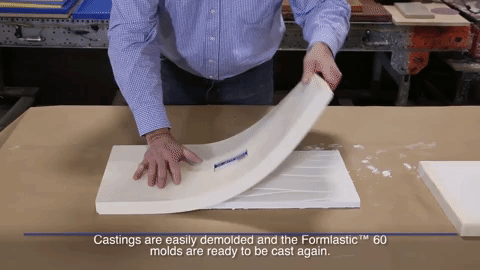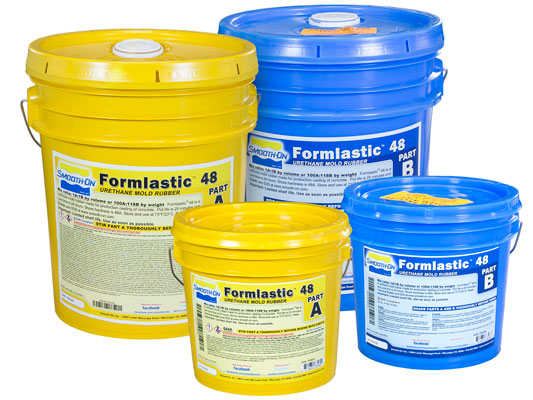Formlastic™ 48
Formlastic™ 48 urethane is a durable mold rubber made for production casting of concrete. It features a low viscosity for easy mixing and pouring and cures with minimal bubble entrapment. Mix ratio is 1A:1B by volume, pot life is 25 minutes and the rubber cures with an ultimate Shore hardness of Shore 48A. Cured rubber is dimensionally stable (low shrinkage), offers good wear resistance and will render color accurate concrete castings.
IMPORTANT: This product does not contain crystalline silica.
Instructions
START BY PREPARING YOUR MODEL...
Preparation - Store and use at room temperature (73°F/23°C). These products have a limited shelf life and should be used as soon as possible. Environmental humidity should be as low as possible. Good ventilation (room size) is essential. Wear safety glasses, long sleeves and rubber gloves to minimize contamination risk.
Some Materials Must Be Sealed - Models with porous surfaces (gypsum plasters, concrete, wood, stone, etc.) must be sealed prior to applying a release agent. Sonite™ Wax (available from Smooth-On distributors) is a proven sealer for porous surfaces.
Non-Porous Surfaces - Metal, glass, hard plastics, sulfur free clays, etc. require only a release agent.
Applying A Release Agent - Use a release agent made specifically for mold making (Universal™ Mold Release available from Smooth-On distributors). A liberal coat of release agent should be applied onto all surfaces that will contact the rubber.
IMPORTANT: To ensure thorough coverage, lightly brush the release agent with a soft brush over all surfaces of the model. Follow with a light mist coating and let the release agent dry for 30 minutes. Because no two applications are quite the same, a small test application to determine suitability for your project is recommended if performance of this material is in question.
MEASURING & MIXING...
Liquid urethanes are moisture sensitive and will absorb atmospheric moisture. Mixing tools and containers should be clean and made of metal or plastic. Materials should be stored and used in a warm environment (73°F/23°C).
Important; Pre-Mix Part B Before Using. Using a flat edge paddle or a drill mixer, scrape sides and bottom of container several times.
POURING...
For best results, pour your mixture in a single spot at the lowest point of the containment field. Let the rubber seek its level up and over the model. A uniform flow will help minimize entrapped air. The liquid rubber should level off at least 1/2” (1.3 cm) over the highest point of the model surface.
CURING & PERFORMANCE...
Curing - Allow rubber to cure a minimum of 24 hours at room temperature (73°F/23°C) before using. Cure time can be reduced with mild heat or by adding Smooth-On Kick-It™ Cure Accelerator. Do not cure rubber where temperature is less than 65°F/18°C.
Post Curing - Optional . . . Following a 24 hour cure, heating the rubber to 150°F (65°C) for 4 to 8 hours will increase physical properties and performance.
Using The Mold - A release agent should be applied to the mold before each casting. Aquacon™ Water Based Release Agent (available from Smooth-On distributors) is recommended for releasing abrasive materials like concrete.
Performance & Storage - Fully cured rubber is tough, durable and will perform if properly used and stored. Molds should be stored on a level surface at room temperature in a dry environment. Do not stack molds, expose them to moisture or UV light for prolonged periods.
Related Categories: Urethane Rubber
Related Series: Formlastic™ Series – For Production Casting of Concrete
How-To Articles

How To Make a Mold For Casting Concrete Tiles
Learn the steps needed to make a production countertop mold using Formlastic™
